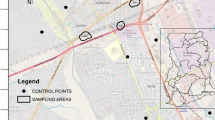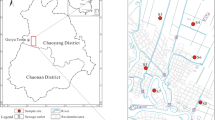Abstract
The total concentrations of 12 heavy metals in surface soils (SS, 0–20 cm), middle soils (MS, 30–50 cm) and deep soils (DS, 60–80 cm) from an acid-leaching area, a deserted paddy field and a deserted area of Guiyu were measured. The results showed that the acid-leaching area was heavily contaminated with heavy metals, especially in SS. The mean concentrations of Ni, Cu, Zn, Cd, Sn, Sb and Pb in SS from the acid-leaching area were 278.4, 684.1, 572.8, 1.36, 3,472, 1,706 and 222.8 mg/kg, respectively. Heavy metal pollution in the deserted paddy field was mainly concentrated in SS and MS. The average values of Sb in SS and MS from the deserted paddy field were 16.3 and 20.2 mg/kg, respectively. However, heavy metal contamination of the deserted area was principally found in the DS. Extremely high concentrations of heavy metals were also observed at some special research sites, further confirming that the level of heavy metal pollution was very serious. The geoaccumulation index (Igeo) values revealed that the acid-leaching area was severely polluted with heavy metals in the order of Sb > Sn > Cu > Cd > Ni > Zn > Pb, while deserted paddy field was contaminated predominately by metals in the order of Sb > Sn > Cu. It was obvious that the concentrations of some uncommon contaminants, such as Sb and Sn, were higher than principal contaminants, such as Ni, Cu, Zn and Pb, suggesting that particular attention should be directed to Sn and Sb contamination in the future research of heavy metals in soils from e-waste-processing areas. Correlation analysis suggested that Li and Be in soils from the acid-leaching area and its surrounding environment might have originated from other industrial activities and from batteries, whereas Ni, Cu, Zn, Cd, Pb, Sn and Sb contamination was most likely caused by uncontrolled electronic waste (e-waste) processing. These results indicate the significant need for optimisation of e-waste-dismantling technologies and remediation of polluted soil environment.



Similar content being viewed by others
References
Bi X, Thomas GO, Jones KC, Qu W, Sheng G, Martin FL, Fu J (2007) Exposure of electronics dismantling workers to polybrominated diphenyl ethers, polychlorinated biphenyls, and organochlorine pesticides in South China. Environ Sci Technol 41(16):5647–5653
Borůvka L, Vacek O, Jehlička J (2005) Principal component analysis as a tool to indicate the origin of potentially toxic elements in soils. Geoderma 128(3):289–300
Cui J, Zhang L (2008) Metallurgical recovery of metals from electronic waste: a review. J Hazard Mater 158(2–3):228–256
Deng WJ, Louie PKK, Liu WK, Bi XH, Fu JM, Wong MH (2006) Atmospheric levels and cytotoxicity of PAHs and heavy metals in TSP and PM2.5 at an electronic waste recycling site in southeast China. Atmos Environ 40(36):6945–6955
Ferancová A, Adamovski M, Gründler P, Zima J, Barek J, Mattusch J, Wennrich R, Labuda J (2007) Interaction of tin (II) and arsenic (III) with DNA at the nanostructure film modified electrodes. Biogeosciences 71(1):33–37
Fu J, Zhou Q, Liu J, Liu W, Wang T, Zhang Q, Jiang G (2008) High levels of heavy metals in rice (Oryza sativa L.) from a typical e-waste recycling area in southeast China and its potential risk to human health. Chemosphere 71(7):1269–1275
Gebel T (1997) Arsenic and antimony: comparative approach on mechanistic toxicology. Chem Biol Interact 107(3):131–144
Gullett BK, Linak WP, Touati A, Wasson SJ, Gatica S, King CJ (2007) Characterization of air emissions and residual ash from open burning of electronic wastes during simulated rudimentary recycling operations. J Mater Cycles Waste Manag 9(1):69–79
Hu Y, Liu X, Bai J, Shih K, Zeng EY, Cheng H (2013) Assessing heavy metal pollution in the surface soils of a region that had undergone three decades of intense industrialization and urbanization. Environ Sci Pollut Res 20(9):6150–6159
Kahhat R, Kim J, Xu M, Allenby B, Williams E, Zhang P (2008) Exploring e-waste management systems in the United States. Resour Conserv Recycl 52(7):955–964
Kantarelis E, Yang W, Blasiak W, Forsgren C, Zabaniotou A (2011) Thermochemical treatment of e-waste from small household appliances using highly pre-heated nitrogen-thermogravimetric investigation and pyrolysis kinetics. Appl Energy 88(3):922–929
Lehner T, Vikdahl A (1998) Integrated recycling of non-ferrous metals at Boliden Ltd. Ronnskar smelter. IEEE International Symbosium on Electronics & the Enviroment, pp 353–362
Leung AO, Luksemburg WJ, Wong AS, Wong MH (2007) Spatial distribution of polybrominated diphenyl ethers and polychlorinated dibenzo-p-dioxins and dibenzofurans in soil and combusted residue at Guiyu, an electronic waste recycling site in southeast China. Environ Sci Technol 41(8):2730–2737
Li H, Yu L, Sheng G, Fu J, Pa P (2007a) Severe PCDD/F and PBDD/F pollution in air around an electronic waste dismantling area in China. Environ Sci Technol 41(16):5641–5646
Li J, Duan H, Shi P (2011) Heavy metal contamination of surface soil in electronic waste dismantling area: site investigation and source-apportionment analysis. Waste Manag Res 29(7):727–738
Li J, Lu H, Guo J, Xu Z, Zhou Y (2007b) Recycle technology for recovering resources and products from waste printed circuit boards. Environ Sci Technol 41(6):1995–2000
Liu J, Zhang XH, Tran H, Wang DQ, Zhu YN (2011) Heavy metal contamination and risk assessment in water, paddy soil, and rice around an electroplating plant. Environ Sci Pollut Res 18(9):1623–1632
Liu M, Huang B, Bi X, Ren Z, Sheng G, Fu J (2013) Heavy metals and organic compounds contamination in soil from an e-waste region in South China. Environ Sci Process Impacts 15(5):919–929
Luo CL, Liu CP, Wang Y, Liu XA, Li FB, Zhang G, Li XD (2011) Heavy metal contamination in soils and vegetables near an e-waste processing site, south China. J Hazard Mater 186(1):481–490
Luo Y, Yu XH, Yang ZY, Yuan JG, Mai BX (2008) Studies on heavy metal contamination by improper handling of e-waste and its environmental risk evaluation. I: heavy metal contamination in e-waste open burning sites. Asian J Ecotoxicol 3(1):34–41
Muller G (1969) Index of geoaccumulation in sediments of the Rhine River. Geophys J R Astron Soc 2(3):108–118
Nan Z, Zhao C, Li J, Chen F, Sun W (2002) Relations between soil properties and selected heavy metal concentrations in spring wheat (Triticum aestivum L.) grown in contaminated soils. Water Air Soil Pollut 133:205–213
Pant D, Joshi D, Upreti MK, Kotnala RK (2012) Chemical and biological extraction of metals present in E waste: a hybrid technology. Waste Manag 32(5):979–990
Peng PA, Sheng GY, Fu JM (2009) The pollution by electronic and electric wastes. Prog Chem 21(2/3):550–557 (in Chinese)
Rath SS, Nayak P, Mukherjee PS, Chaudhury GR, Mishra BK (2012) Treatment of electronic waste to recover metal values using thermal plasma coupled with acid leaching - a response surface modeling approach. Waste Manag 32(3):575–583
Robinson BH (2009) E-waste: an assessment of global production and environmental impacts. Sci Total Environ 408(2):183–191
SEPA (State Environmental Protection Administration) (1995) Environmental quality standard for soils (GB15618-1995), Standards Press of China, Beijing
Shen CF, Huang SB, Wang ZJ, Qiao M, Tang XJ, Yu CN, Shi DZ, Zhu YF, Shi JY, Chen XC, Setty K, Chen YX (2007) Identification of Ah receptor agonists in soil of E-waste recycling sites from Taizhou area in China. Environ Sci Technol 42(1):49–55
Silva CR, Oliveira MBN, Melo SF, Dantas FJS, De Mattos JCP, Bezerra RJCA, Caldeira-de-Araujo A, Duatti A, Bernardo-Filho M (2002) Biological effects of stannous chloride, a substance that can produce stimulation or depression of the central nervous system. Brain Res Bull 59(3):213–216
Tang X, Shen C, Chen L, Xiao X, Wu J, Khan MI, Dou C, Chen Y (2010a) Inorganic and organic pollution in agricultural soil from an emerging e-waste recycling town in Taizhou area, China. J Soils Sediments 10(5):895–906
Tang XJ, Shen CF, Shi DZ, Cheema SA, Khan MI, Zhang CK, Chen YX (2010b) Heavy metal and persistent organic compound contamination in soil from Wenling: an emerging e-waste recycling city in Taizhou area, China. J Hazard Mater 173(1–3):653–660
Terazono A, Murakami S, Abe N, Inanc B, Moriguchi Y, S-i S, Kojima M, Yoshida A, Li J, Yang J (2006) Current status and research on E-waste issues in Asia. J Mater Cycles Waste Manag 8(1):1–12
Tschan M, Robinson BH, Schulin R (2009) Antimony in the soil–plant system—a review. Environ Chem 6(2):106–115
VROM (2000) Intervention values and target values; soil quality standards, Ministry of Housing, Spatial Planning and Environment, Department of Soil Protection, The Hague, Netherlands
Wei FS, Chen JS, Wu YY, Zheng CJ (1991) Research on background values of soils in China. J Environ Sci China 12(4):12–19 (in Chinese)
Wong CS, Duzgoren-Aydin NS, Aydin A, Wong MH (2007a) Evidence of excessive releases of metals from primitive e-waste processing in Guiyu, China. Environ Pollut 148(1):62–72
Wong MH, Wu SC, Deng WJ, Yu XZ, Luo Q, Leung AO, Wong CS, Luksemburg WJ, Wong AS (2007b) Export of toxic chemicals—a review of the case of uncontrolled electronic-waste recycling. Environ Pollut 149(2):131–140
Yang RX, Luo CL, Zhang G, Li XD, Shen ZG (2012) Extraction of heavy metals from e-waste contaminated soils using EDDS. J Environ Sci China 24(11):1985–1994
Yang YC, Xue MQ, Xu ZM, Huang C (2013) Health risk assessment of heavy metals (Cr, Ni, Cu, Zn, Cd, Pb) in circumjacent soil of a factory for recycling waste electrical and electronic equipment. J Mater Cycles Waste Manag 15(4):556–563
Yu XZ, Gao Y, Wu SC, Zhang HB, Cheung KC, Wong MH (2006) Distribution of polycyclic aromatic hydrocarbons in soils at Guiyu area of China, affected by recycling of electronic waste using primitive technologies. Chemosphere 65(9):1500–1509
Zhang HB, Luo YM, Wong MH, Zhao QG, Zhang GL (2006) Distributions and concentrations of PAHs in Hong Kong soils. Environ Pollut 141(1):107–114
Zhang JH, Min H (2009) Eco-toxicity and metal contamination of paddy soil in an e-wastes recycling area. J Hazard Mater 165(1):744–750
Zhang WH, Wu YX, Simonnot MO (2012) Soil contamination due to e-waste disposal and recycling activities: a review with special focus on China. Pedosphere 22(4):434–455
Zhao G, Zhou H, Wang D, Zha J, Xu Y, Rao K, Ma M, Huang S, Wang Z (2009) PBBs, PBDEs, and PCBs in foods collected from e-waste disassembly sites and daily intake by local residents. Sci Total Environ 407(8):2565–2575
Acknowledgments
This work was supported by the Key Project of the Chinese Academy of Sciences Comprehensive Strategic Cooperation with Guangdong Province (No. 2012B090400030), Guangdong Natural Science Funds for Distinguished Young Scholar (No. S2013050014122) and the GIGCAS 135 project Y234021001. This is contribution No. IS-1943 from GIGCAS.
Author information
Authors and Affiliations
Corresponding author
Additional information
Responsible editor: Zhihong Xu
Electronic supplementary material
Below is the link to the electronic supplementary material.
ESM 1
(PDF 268 kb)
Rights and permissions
About this article
Cite this article
Quan, SX., Yan, B., Yang, F. et al. Spatial distribution of heavy metal contamination in soils near a primitive e-waste recycling site. Environ Sci Pollut Res 22, 1290–1298 (2015). https://doi.org/10.1007/s11356-014-3420-8
Received:
Accepted:
Published:
Issue Date:
DOI: https://doi.org/10.1007/s11356-014-3420-8




